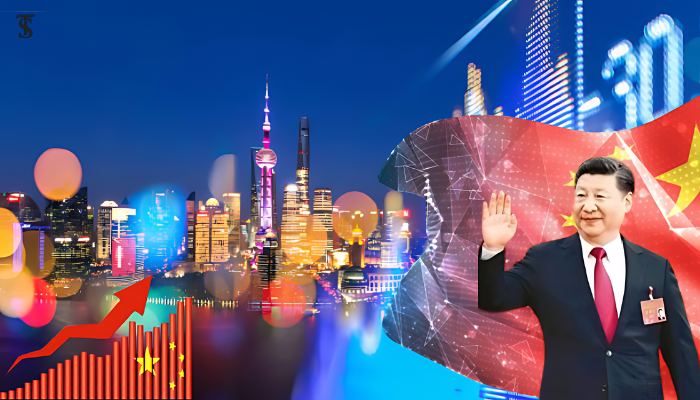The Peaceful Rise of China

- Economic and Diplomatic Influence: China’s rise is driven by economic growth and strategic diplomacy, exemplified by initiatives like the Belt and Road Initiative (BRI) and the Regional Comprehensive Economic Partnership (RCEP), which strengthen trade, connectivity, and regional integration.
- Soft Power and Technology: Through soft power, including Confucius Institutes and the Digital Silk Road, China extends its cultural and technological influence globally, fostering partnerships and enhancing its global reach.
- Challenges and Criticisms: Despite its peaceful approach, China faces challenges like “Debt Diplomacy,” regional disputes, and international criticism on human rights, indicating potential limits to its strategy of peaceful influence.
Sun Tzu once said, “The greatest victory requires no battle.” In today’s world, his ancient wisdom resonates through the rise of China, a nation conquering not with military might, but through strategic and peaceful means. China’s journey to global prominence is a modern-day testament to Sun Tzu’s philosophy—a shift reshaping global power dynamics in unprecedented ways.
China’s rise began decades ago with a strategy centered on economic growth. From a struggling economy in the 1980s, China now stands as the world’s second-largest economy. With a GDP that leaped from $200 billion in 1980 to over $18.5 trillion in 2024, China’s meteoric economic rise is remarkable. Averaging a 9.5% growth rate over 40 years, and also lifted 800 million people out of poverty, establishing itself as a key player in the global economy. The story doesn’t end there. China’s dominance extends far beyond its borders. Its manufacturing output accounts for 28% of the world’s total, making it a critical part of global supply chains. However, China’s journey from a manufacturing base to a tech powerhouse is just one part of its grand strategy.
A key component of China’s peaceful rise is its ambitious Belt and Road Initiative (BRI), a massive infrastructure project that spans across continents. Investing over $1 trillion, China has built bridges—both literally and figuratively—with more than 60 countries. In Pakistan, for example, the China-Pakistan Economic Corridor (CPEC) brings $62 billion in investments, boosting economic growth and regional connectivity. In Africa, China has invested around $150 billion, in developing essential infrastructure like roads, railways, and ports.
These projects are creating jobs and driving development, but not without their challenges. Countries risk falling into debt traps, with some critics coining the term “Debt Diplomacy.” Local communities may face economic vulnerabilities and environmental impacts, but China’s influence continues to grow, as does its reach into global markets.
In the realm of trade, China has positioned itself as a leader, not just a participant. The Regional Comprehensive Economic Partnership (RCEP), which links 15 Asia-Pacific economies, has reinforced China’s status in the international trading community. However, the pact amplifies regional integration and strengthens China’s economic clout, especially in a world seeking post-pandemic recovery.
China’s diplomatic strategies also align with its peaceful rise. Following a non-interventionist foreign policy, China maintains strong bilateral and multilateral relations. Through platforms like the Forum on China-Africa Cooperation (FOCAC), China continues to build partnerships based on mutual benefits, further enhancing its global leadership.
In addition to economic and diplomatic influence, China has turned to soft power to extend its global reach. The expansion of Confucius Institutes worldwide showcases its effort to promote language and cultural understanding. These institutes, along with educational scholarships for students from developing nations, symbolize China’s commitment to shared growth and mutual knowledge. China’s technological advancements further solidify its influence. Tech giants like Huawei and Alibaba have made significant strides in fields like artificial intelligence and e-commerce, driving the nation’s Digital Silk Road initiative. This technological diplomacy strengthens ties with BRI countries, enhancing China’s global connectivity.
While China’s military modernization continues, it operates under a defensive doctrine. China’s participation in peacekeeping efforts with over 40,000 personnel deployed in UN missions underscores its commitment to global security. At the same time, China plays a key role in international forums like the G20, promoting multilateral cooperation. By balancing military strength with diplomacy, China maintains regional stability while upholding its peaceful rise. Its commitment to environmental initiatives is another part of its global strategy. As the world’s largest producer of solar panels and wind turbines, China has invested USD 680 billion in 2024.
However, The Green Belt and Road Initiative focuses on sustainable infrastructure, blending economic growth with environmental protection. This initiative not only helps China meet its climate goals but also positions the country as a leader in the global green economy. From building solar power plants in Africa to wind farms in Southeast Asia, China’s influence stretches across the globe, aligning its peaceful rise with sustainable development.
Despite China’s peaceful approach, its rise is not without challenges. “Debt Diplomacy” threatens the sovereignty of nations unable to repay BRI loans, as seen in Sri Lanka. Rapid economic growth has created inequality within China, leaving rural areas behind while cities thrive. Regional disputes, particularly in the South China Sea, have raised tensions with neighboring countries, and China’s handling of human rights issues in Xinjiang and Hong Kong has drawn international criticism.
China continues to grow. Its peaceful rise, built on economic, diplomatic, and cultural foundations, reflects the ancient strategist’s ideal: victory without conflict and profoundly reshaping the world. While challenges lie ahead, China’s approach offers a new blueprint for global leadership, demonstrating that peaceful influence can be as powerful as military might.
The views and opinions expressed in this article/paper are the author’s own and do not necessarily reflect the editorial position of The Spine Times.

Shanzay Ashfaq
The author is an expert in peace and conflict studies, currently pursuing her MS in Strategic Studies. Her research focuses on security, human security, and gender, aiming to develop inclusive solutions for national and global challenges.




very well explained…
surely its an unusual terrain to glorywhat China is pursuing.
very well explained…
surely its an unusual terrain to glory what China is pursuing
Smartcric This is really interesting, You’re a very skilled blogger. I’ve joined your feed and look forward to seeking more of your magnificent post. Also, I’ve shared your site in my social networks!